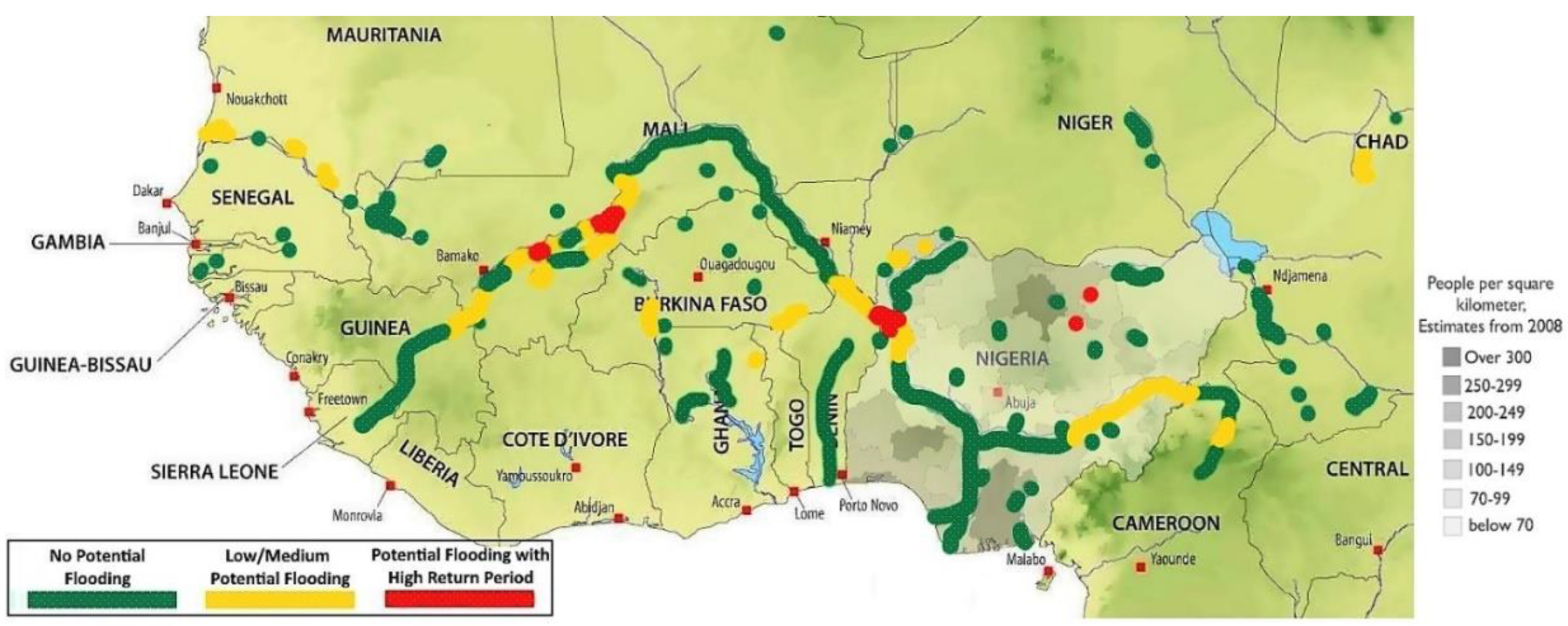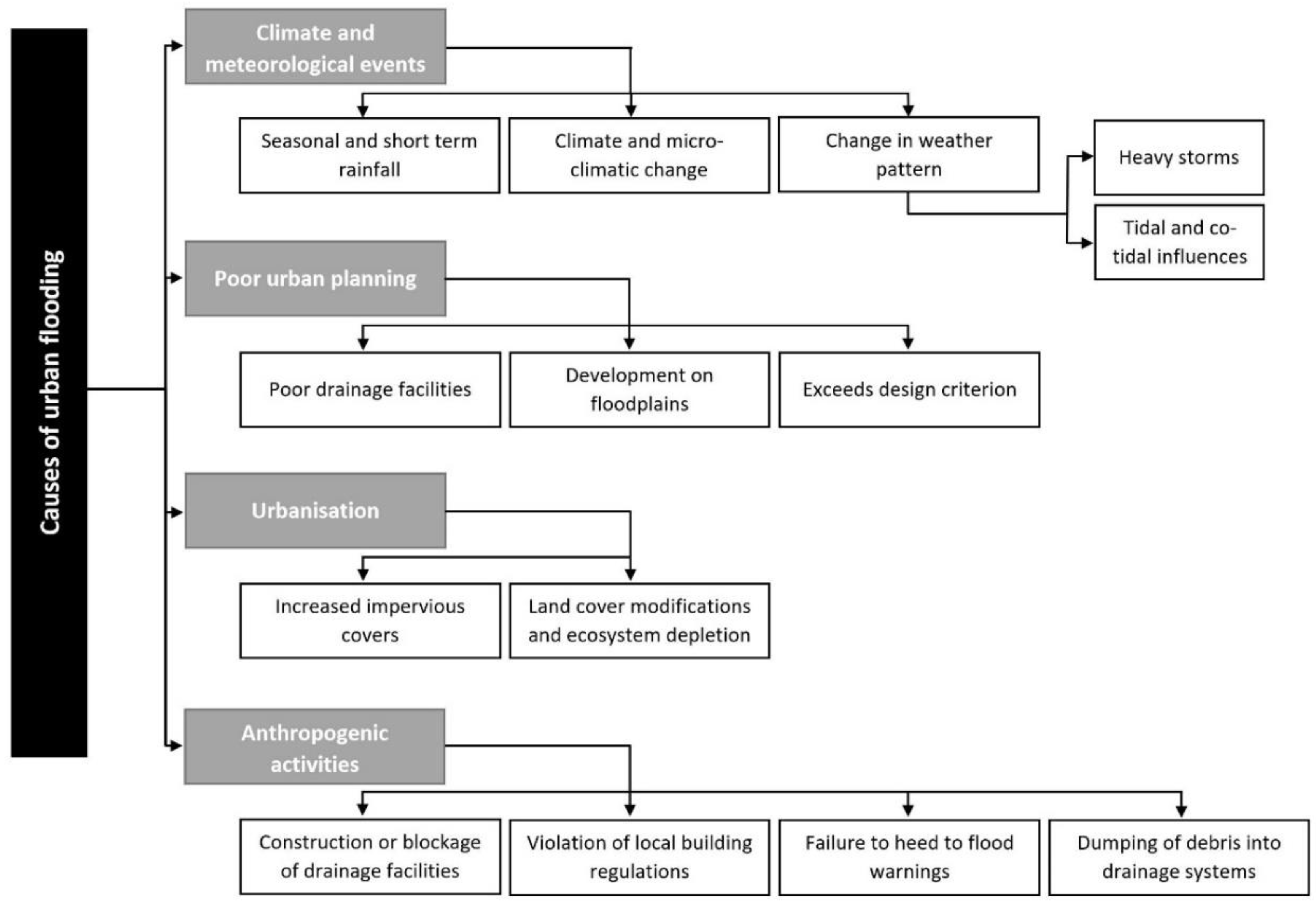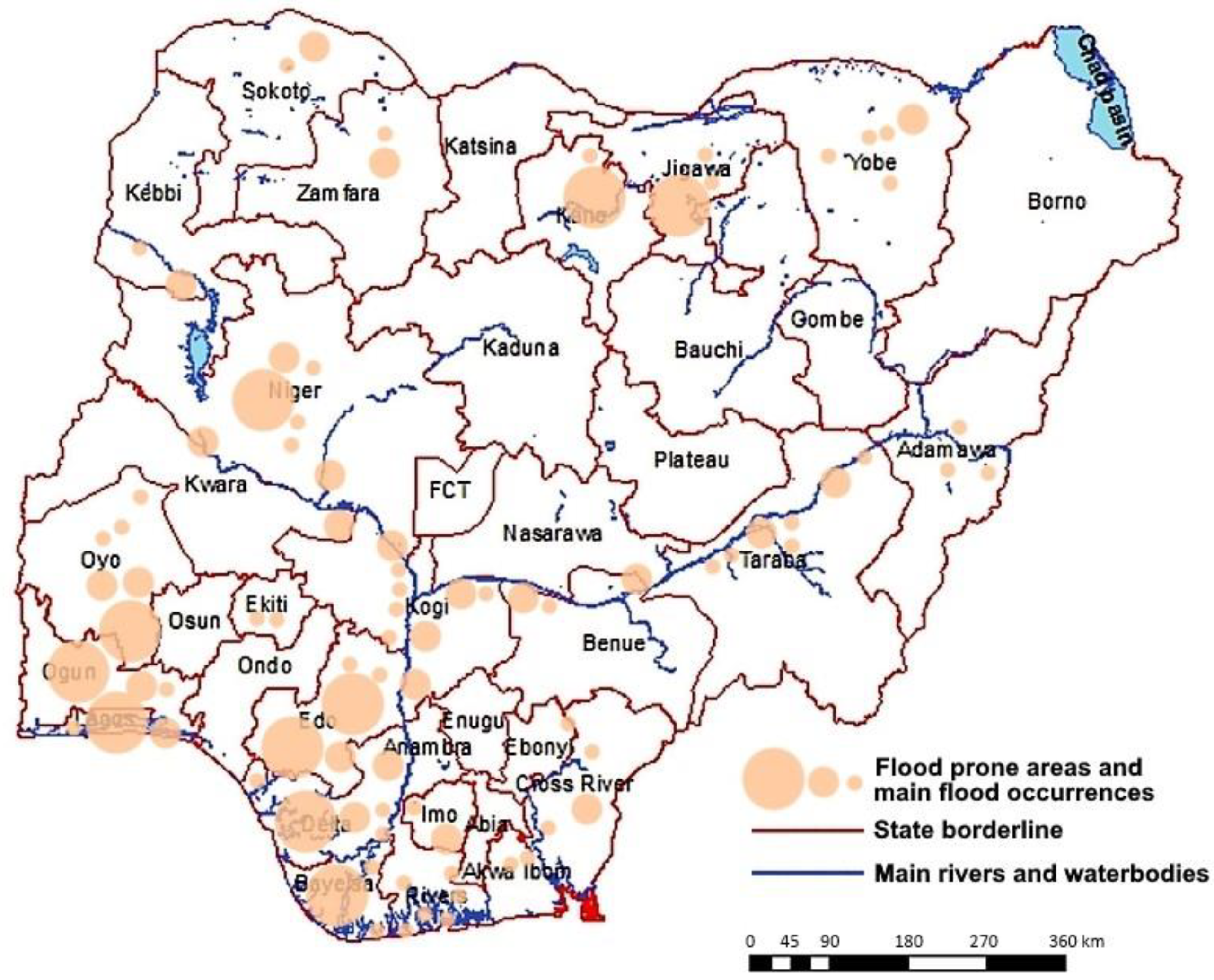Flooding Conceptual Review: Sustainability-Focalized Best Practices in Nigeria
Abstract
:1. Introduction
2. Flood Impact in Nigeria
3. Statement of Problem
4. Methodology
5. Conceptual Framework
5.1. Definition of Flooding
5.2. Causes of Flooding
5.3. Impact of Climate Change on Floods
5.4. Urbanisation and Floods
5.5. Flood Prediction
5.6. Flood Occurrences
6. Discussion: Flood Control and Management
International Flood Management Practices: Sustainable Flood Prevention, Protection and Mitigation
7. Conclusions
Author Contributions
Funding
Conflicts of Interest
References
- UNOCHA. Nigeria: Humanitarian Response Plan; United Nations Office for the Coordination of Humanitarian Affairs: Abuja, Nigeria, 2018. [Google Scholar]
- Onuigbo, I.C.; Ibrahim, P.O.; Agada, D.U.; Nwose, I.A.; Abimbola, I.I. Flood Vulnerability Mapping of Lokoja Metropolis Using Geographical Information System Techniques. J. Geosci. Geomatics 2017, 5, 229–242. [Google Scholar] [CrossRef] [Green Version]
- Jeb, D.N.; Aggarwal, S.P. Flood Inundation Hazard Modelling of the River Kaduna Using Remote Sensing and Geographic Information Systems. J. Appl. Sci. 2008, 4, 1822–1833. [Google Scholar]
- OECD. Financial Management of Flood Risk; OECD Publishing: Paris, France, 2016. [Google Scholar]
- Lin, B.B.; Philpott, S.M.; Jha, S. The Future of Urban Agriculture and Biodiversity-Ecosystem Services: Challenges and Next Steps. Basic Appl. Ecol. 2015, 16, 189–201. [Google Scholar] [CrossRef]
- Paterson, D.L.; Wright, H.; Harris, P.N.A. Health Risks of Flood Disasters. Clin. Infect. Dis. 2018. [Google Scholar] [CrossRef]
- Komolafe, A.A.; Adegboyega, S.A.-A.A.; Akinluyi, F.O. A Review of Flood Risk Analysis in Nigeria. Am. J. Environ. Sci. 2015, 11, 157–166. [Google Scholar] [CrossRef]
- UNOCHA. Humanitarian Bulletin Nigeria; United Nations Office for the Coordination of Humanitarian Affairs: Abuja, Nigeria, 2015. [Google Scholar]
- Etuonovbe, A.K. The Devastating Effect of Flooding in Nigeria; UNOCHA: Marrakech, Morocco, 2011. [Google Scholar]
- Wisner, B.; Blaikie, P.; Cannon, T.; Davis, I. At Risk: Natural Hazards, People’s Vulnerability and Disasters, 2nd ed.; Routledge-UNDP: London, UK, 2003; ISBN 0415084768. [Google Scholar]
- Brown, I.; Chikagbum, W. Planning Response to Water-Related Disasters in Nigeria: The Rivers State Experience. Int. J. Sci. Eng. Res. 2015, 6, 32–44. [Google Scholar]
- Ade, M.A. The menace of Floods in the Benue Trough and Vulnerability Analysis: 2017 Flood. In Geophysical Research Abstracts, 8–13 April 2018; European Geosciences Union: Vienna, Austria, 2018; Volume 20, p. 3. [Google Scholar]
- Isma, M.; Saanyol, I.O. Application of Remote Sensing (RS) and Geographic Information Systems (GIS) in Flood Vulnerability Mapping: Case Study of River Kaduna. Int. J. Geomatics Geosci. 2013, 3, 618–627. [Google Scholar]
- Ologunorisa, T.E.E.; Abawua, M.J. Flood Risk Assessment: A Review. J. Appl. Sci. Environ. Manag. 2005, 9, 57–63. [Google Scholar]
- Okoduwa, A.I. An Application of GIS to Flood Prediction: A Case Study of Benin City, Nigeria. Bachelor’s Thesis, Department of Geography and Planning, University of Benin, Benin, Nigeria, 1999. [Google Scholar]
- International Water Management Institute. Flood Risk Mapping: Nigeria—IWMI. Available online: http://waterdata.iwmi.org/Applications/nigeria_Flood_Mapping/ (accessed on 31 July 2018).
- Agbola, B.S.; Ajayi, O.; Taiwo, O.J.; Wahab, B.W. The August 2011 flood in Ibadan, Nigeria: Anthropogenic Causes and Consequences. Int. J. Disaster Risk Sci. 2012, 3, 207–217. [Google Scholar] [CrossRef]
- Tokunbo, A.; Ezigbo, B. Floods Claims 363 Lives, Displace 2.1 People Says NEMA; All African: Ibadan, Nigeria, 2012.
- Agbonkhese, O.; Aka, E.G.; Ocholi, J.; Adekunle, M. Flood Menace in Nigeria: Impacts, Remedial and Management Strategies. Civ. Environ. Res. 2014, 6, 32–41. [Google Scholar]
- Oluwaseyi, A.B. Plant Genetic Resources (PGR) in Nigeria and the Reality of Climate Change: A review. Asian J. Environ. Ecol. 2017, 2, 1–24. [Google Scholar] [CrossRef]
- Jha, A.K.; Bloch, R.; Lamond, J. Cities and flooding: A Guide to Integrated Urban Flood Risk Management for the 21st Century; The World Bank: Washington, DC, USA, 2012; ISBN 9780821388662. [Google Scholar]
- Adekola, O.; Lamond, J. A Media Framing Analysis of Urban Flooding in Nigeria: Current narratives and Implications for Policy. Reg. Environ. Chang. 2018, 18, 1145–1159. [Google Scholar] [CrossRef]
- UNOCHA. 2013 Rainy Season Overview West and Central Africa Rainfall Patterns; United Nations Office for the Coordination of Humanitarian Affairs: Abuja, Nigeria, 2013. [Google Scholar]
- Dunning, C.M.; Black, E.C.L.; Allan, R.P. The Onset and Cessation of Seasonal Rainfall over Africa. J. Geophys. Res. 2016, 121, 11405–11424. [Google Scholar] [CrossRef]
- Wikipedia Nigeria. Available online: https://en.wikipedia.org/wiki/Nigeria (accessed on 19 July 2018).
- Matarese, V. Using Strategic, Critical Reading of Research Papers to Teach Scientific Writing: The reading–Research–Writing Continuum. In Supporting Research Writing; Elsevier: Oxford, UK, 2013; pp. 73–89. [Google Scholar]
- Nkwunonwo, U.C.; Whitworth, M.; Baily, B. Review article: A Review and Critical Analysis of the Efforts towards Urban Flood Risk Management in the Lagos Region of Nigeria. Nat. Hazards Earth Syst. Sci. 2016, 16, 349–369. [Google Scholar] [CrossRef]
- FEMA. Flood Risk Assessment. In Hazard Identification and Risk Assessment; FEMA, Ed.; Department of Homeland Security: Washington, DC, USA, 2012; p. 25. [Google Scholar]
- Walesh, S.G. Urban Surface Water Management; John Wiley and Sons: Hoboken, NJ, USA, 1989; ISBN 9780470172810. [Google Scholar]
- Ojo, A.O. The Climatic Dilemma; Lagos State University: Ojo, Nigeria, 2007. [Google Scholar]
- Rosenzweig, C.; Solecki, W.D.; Parshall, L.; Lynn, B.; Cox, J.; Goldberg, R.; Hodges, S.; Gaffin, S.; Slosberg, R.B.; Savio, P.; et al. Mitigating New York City’s Heat Island: Integrating Stakeholder Perspectives and Scientific Evaluation. Bull. Am. Meteorol. Soc. 2009, 90, 1297–1312. [Google Scholar] [CrossRef]
- Chow, V.T. Report of the Committee on Runoff, 1955–1956. Trans. Am. Geophys. Union 1957, 38, 379–384. [Google Scholar] [CrossRef]
- Patra, K.C. Hydrology and Water Resources Engineering; Alpha Science International: Oxford, UK, 2001; ISBN 1842650238. [Google Scholar]
- Whitworth Malcolm, N.U.; Malcolm, W.; Brian, B. Flooding and Flood Risk Reduction in Nigeria: Cardinal Gaps. J. Geogr. Nat. Disasters 2015, 5, 136. [Google Scholar] [CrossRef]
- Adeloye, A.J.; Rustum, R. Lagos (Nigeria) Flooding and Influence of Urban Planning. Proc. Inst. Civ. Eng.—Urban Des. Plan. 2011, 164, 175–187. [Google Scholar] [CrossRef]
- Aderogba, K.A. Qualitative Studies of Recent Floods and Sustainable Growth and Development of Cities and Towns in Nigeria. Int. J. Acad. Res. Econ. Manag. Sci. 2012, 1, 1. [Google Scholar] [CrossRef]
- IPCC. Climate Change 2014: Synthesis Report. Contribution of Working Groups I, II and III to the Fifth Assessment Report of the Intergovernmental Panel on Climate Change; Intergovernmental Panel on Climate Change: Geneva, Switzerland, 2014; ISBN 9789291691432. [Google Scholar]
- Martel, J.-L.; Mailhot, A.; Brissette, F.; Caya, D.; Martel, J.-L.; Mailhot, A.; Brissette, F.; Caya, D. Role of Natural Climate Variability in the Detection of Anthropogenic Climate Change Signal for Mean and Extreme Precipitation at Local and Regional Scales. J. Clim. 2018, 31, 4241–4263. [Google Scholar] [CrossRef]
- O’Hare, G. Climate Change and the Temple of Sustainable Development. Geography 2002, 87, 234–246. [Google Scholar] [CrossRef]
- Ogbonna, D.; Okoro, B.C.; Osuagwu, J.C. Application of Flood Routing Model for Flood Mitigation in Orashi River, South-East Nigeria. J. Geosci. Environ. Prot. 2017, 5, 31–42. [Google Scholar] [CrossRef]
- Seto, K.C.; Kaufmann, R.K. Urban Growth in South China and Impacts on Local Precipitation. In Proceedings of the Fifth Urban Research Symposium, Marseille, France, 28–30 June 2009. [Google Scholar]
- Bentley, M.L.; Ashley, W.S.; Anthony Stallins, J. Climatological Radar Delineation of Urban Convection for Atlanta, Georgia. Int. J. Climatol. 2010, 30, 1589–1594. [Google Scholar] [CrossRef]
- Huong, H.T.L.; Pathirana, A. Urbanization and Climate Change Impacts on Future Urban Flood Risk in Can Tho city, Vietnam. Hydrol. Earth Syst. Sci. Discuss. 2011, 8, 10781–10824. [Google Scholar] [CrossRef]
- Ubani, O.; Obi, A.N.I. Analysis of Flood Risk Management in Nigerian Urban environment. J. Environ. Earth Sci. 2014, 4, 110–115. [Google Scholar]
- Adekola, P.; Ogundipe, A. An Assessment of the State of Environmental Management in Nigerian Capital Cities. J. Geogr. Environ. Earth Sci. Int. 2017, 12, 1–13. [Google Scholar] [CrossRef]
- Fohringer, J.; Dransch, D.; Kreibich, H.; Schröter, K. Social Media as an Information Source for Rapid Flood Inundation Mapping. Nat. Hazards Earth Syst. Sci. 2015, 15, 2725–2738. [Google Scholar] [CrossRef]
- Addor, N.; Jaun, S.; Fundel, F.; Zappa, M. An Operational Hydrological Ensemble Prediction System for the City of Zurich (Switzerland): Assessing the Added Value of Probabilistic Forecasts. Hydrol. Earth Syst. Sci. 2012, 14, 2327–2347. [Google Scholar]
- Pfister, N. The Role of the New South Wales State Emergency Service in Flood Management; SES: Wollongong, Australia, 2005. [Google Scholar]
- Olowu, D.; Sako, S. Better Governance and Public Policy: Capacity Building for Democratic Renewal in Africa; Kumarian Press: Bloomfield, CT, USA, 2002; ISBN 9781565491601. [Google Scholar]
- Olowoyo, J.O.; Lion, G.N. Urban Farming as a Possible Source of Trace Metals in Human Diets. S. Afr. J. Sci. 2016, 112, 1–6. [Google Scholar] [CrossRef]
- Edmund, P.R. Flood and Coastal Erosion Risk Management: A Manual for Economic Appraisal; Routledge: Middlesex, UK, 2013; ISBN 0415815150. [Google Scholar]
- Igbokwe, J.I.; Akinyede, J.O.; Dang, B.; Alaga, T.; Ono, M.N.; Nnodu, V.C.; Anike, L.O. Mapping and Monitoring the Impacts of Flood and Erosion in South Eastern Nigeria with Satellite Remote Sensing and Geographic Information System. Int. Arch. Photogramm. Remote Sens. Spat. Inf. Sci. 2008, 37, 865–872. [Google Scholar]
- Onwuka, S.U.; Ikekpeazu, F.O.; Onuoha, D.C. Assessment of the Causes of 2012 Floods in Aguleri and Umuleri, Anambra East Local Government Area of Anambra State, Nigeria. Eff. Br. Mindfulness Interv. Acute Pain Exp. An Exam. Individ. Differ. 2015, 1, 1689–1699. [Google Scholar] [CrossRef]
- UNOCHA. Overview: Impact of Floods West and Central Africa; United Nations Office for the Coordination of Humanitarian Affairs: Abuja, Nigeria, 2012. [Google Scholar]
- Ekpo, U.F.; Hürlimann, E.; Schur, N.; Oluwole, A.S.; Abe, E.M.; Mafe, M.A.; Nebe, O.J.; Isiyaku, S.; Olamiju, F.; Kadiri, M.; et al. Mapping and Prediction of Schistosomiasis in Nigeria Using Compiled Survey Data and Bayesian Geospatial Modelling. Geospat. Health 2013, 7, 355–366. [Google Scholar] [CrossRef] [PubMed]
- Okoye, C.B.; Ojeh, V.N. Mapping of Flood Prone Areas in Surulere, Lagos, Nigeria: A. GIS Approach. J. Geogr. Inf. Syst. 2015, 7, 158–176. [Google Scholar] [CrossRef]
- Ozkan, S.P.; Tarhan, C. Detection of Flood Hazard in Urban Areas Using GIS: Izmir Case. Procedia Technol. 2016, 22, 373–381. [Google Scholar] [CrossRef]
- Hezekiah, A.O. GIS Analysis of Flood Vulnerable Areas in Benin-Owena River Basin, Nigeria. Indones. J. Geogr. 2017, 49, 27A. [Google Scholar] [CrossRef]
- Burton, I. Types of Agricultural Occupance of Flood Plains in the United States; Geografía: Chicago, IL, USA, 1962. [Google Scholar]
- European Commission. Towards an EU Research and Innovation Policy Agenda for Nature-Based Solutions & Re-Naturing Cities; Directorate-General for Research and Innovation, European Commission: Brussels, Belgium, 2015; ISBN 978-92-79-46051-7. [Google Scholar]
- European Environment Agency. The European Environment State and Outlook 2015: Synthesis Report; European Environment Agency: Copenhagen, Denmark, 2015. [Google Scholar]
- FEMA NFIP. Floodplain Management Guidebook, 5th ed.; Federal Emergency Management Agency: Bothell, WA, USA, 2009.
- FEMA. National Flood Insurance Program Community Rating System: A Local Official’s Guide to Saving Lives, Preventing Property Damage, and Reducing the Cost of Flood Insurance FEMA B 573/2018; Federal Emergency Management Agency: Indianapolis, IN, USA, 2018.
- Partners for Action. Perspectives in Flood Risk Assessment and Management: Discussions and Recommendations on Flood Risk Management in Canada. In Proceedings of the CatIQ 2nd Annual Canadian Catastrophe Conference, Toronto, AB, Canada, 3 February 2017. [Google Scholar]
- Australian Institute of Disaster Resilience. Managing the Floodplain: A Guide to Best Practices in Flood Risk Management in Australia: Handbook 7; Australian Government, Attorney-General’s Department: East Melbourne, Australia, 2017.
- Ministry for the Environment. Meeting the Challenges of Future Flooding in New Zealand; Ministry for the Environment: Wellington, New Zealand, 2008.
- Ministry of Environment. Fact Sheet 2: Coastal Flooding Due to Storms; Ministry for the Environment: Wellington, New Zealand, 2017.




| State | Flood Disaster | Other Disasters | Associated Hazards | Affected Population | Year |
|---|---|---|---|---|---|
| Oyo | Ogunpa flood, Ibadan flood | - | 500 houses demolished, properties destroyed, bridges collapsed; 300+ houses destroyed in 2017 | 50,000 displaced; 300+ in 2017 | 1948, 1963, 1978, 1980, 1982, 1985, 1987, 1990, 2011, 2017 |
| Lagos | Lekki flood | - | buildings collapsed, markets submerged, properties destroyed | 300,000+ | from the early 1970s to date |
| Kano | flood | windstorm | schools, houses, farmlands, animals destroyed | 300,000+ displaced in 1988; 20,445 in 2001 | 1988, 2001 |
| Zamfara | flood | - | building submerged, farmlands destroyed, properties damaged | 12,398 | July 2001 |
| Yobe | flood | fire, drought | houses and farmlands submerged, houses razed, animals affected | 100,000+ | April and September, 2001 |
| Sokoto | flood | fire, windstorm | houses and farmlands destroyed | 16,000+ | July 2001 |
| Taraba | flood | - | 80 houses swept away; 410 houses extensively destroyed | 50,000+ displaced | August 2005 |
| Osun | rainstorm | houses and schools destroyed | 17,000+ | April 2001 | |
| Ondo | rainstorm | houses and schools destroyed | 800 | April 2001 | |
| Niger | flood | rainstorm | houses, schools, animals and farmland affected | 200,000+ displaced | 1999, 2000 |
| Kogi | flood | rainstorm | houses, schools and farmland destroyed | 1500 displaced | March and May 2001 |
| Jigawa | flood | windstorm | houses, farmlands and animals destroyed | 35,500 displaced in 1988; 450,150 displaced in 2001 | 1988, March, April and August 2001 |
| Imo | flood | windstorm | 1000 houses; 150 electric poles; 40,000 oil palms destroyed | 10,000+ displaced | April 2001 |
| Ekiti | flood | rainstorm | public schools, 890 houses | 2100 affected | April 2001 |
| Edo | flood | rainstorm | 560 houses destroyed in 2001; State-wide devastation in 2012 | 820 affected in 2001; 3.8 million affected in 2012 | March 2001, 2012 |
| Delta | flood | rainstorm | houses, schools, markets and farmlands submerged | 425,839 affected between all 3 incidences | 1999, March and April 2001 |
| Bayelsa | flood | - | houses, schools, markets and farmlands submerged | 273,266 affected in 1999; 382,000 affected in 2001 | 1999, March 2001 |
| Akwa-Ibom | flood | rainstorm | 367 houses washed away | 4000 | March 2001 |
| Adamawa | flood | rainstorm | houses and farmlands destroyed | 500 | April 2001 |
| Rivers | flood | rainstorm | residential houses, churches, public and private facilities | 350+ affected year-in-year-out | 2006, 2012, 2013, 2017 |
| Cross Rivers | flood | rainstorm | entire communities, public and private facilities | 25,000+ affected | 2017 |
| Anambra | flood | - | residential houses, farmland, public schools and market places destroyed | 500,000+ affected in several communities | 2012, 2017 |
| Ogun | flood | rainstorm, windstorm | residential houses, public and private buildings collapsed, market places destroyed, farmland washed away | 350,000+ affected in several communities | 2012, 2017 |
© 2018 by the authors. Licensee MDPI, Basel, Switzerland. This article is an open access article distributed under the terms and conditions of the Creative Commons Attribution (CC BY) license (http://creativecommons.org/licenses/by/4.0/).
Share and Cite
Cirella, G.T.; Iyalomhe, F.O. Flooding Conceptual Review: Sustainability-Focalized Best Practices in Nigeria. Appl. Sci. 2018, 8, 1558. https://doi.org/10.3390/app8091558
Cirella GT, Iyalomhe FO. Flooding Conceptual Review: Sustainability-Focalized Best Practices in Nigeria. Applied Sciences. 2018; 8(9):1558. https://doi.org/10.3390/app8091558
Chicago/Turabian StyleCirella, Giuseppe T., and Felix O. Iyalomhe. 2018. "Flooding Conceptual Review: Sustainability-Focalized Best Practices in Nigeria" Applied Sciences 8, no. 9: 1558. https://doi.org/10.3390/app8091558






